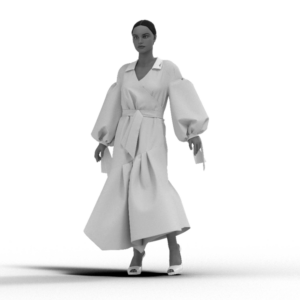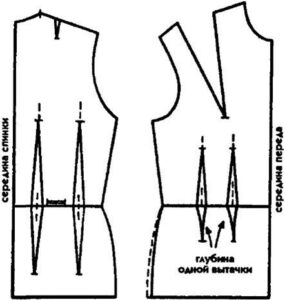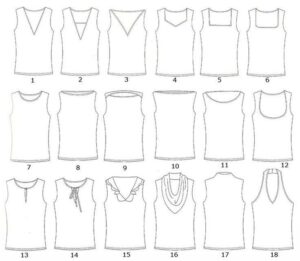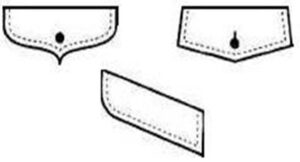Basque is a very feminine detail of a garment. It is a flared piece of fabric. Due to the fact that the part is wider at the bottom than at the top, it looks very decorative. It formalizes the waist line. The fringe can be sewn to the garment, or it can be removable.

A strip is a simple, narrow strip of fabric. Sometimes the strip is folded in two along the length. Neck and armhole cuts are very often worked with a band. Strip is stitched on the cuts. Lace is cut obliquely and straight. Outside the cuts, when the lace is stitched, it can also be a tie, for example. On sale ready to use.

Volans are basically similar in construction to the basque. The only difference is the ratio of the sides. In a flounce, equal sides are equal in length. The long sides (longitudinal sides) are much longer than the short sides. The shorter longitudinal side is stitched to the garment. The longer long side of the pattern has a wavy edge.

A dart is a fold of a part of the fabric that is stitched away. It can be diamond-shaped. Darts and notches form a sewing product volume, shape. Interesting fact. Fasteners on the darts are not put. If they are made on thin fabrics.

Neckline – characterized by the neckline. It has a huge number of varieties. But it is always located in front of the shoulder cut of the product. The type of neckline has a strong influence on the appearance of the garment.

A codpiece is an important, especially for public people, detail of a belted garment. Mostly pants. The front half of them. In fact, it hides the fastener. The fastener can be a zipper, buttons, buttons.

Jabot – Austin Powers immediately comes to mind, wearing a man’s jabot.
The material used to create the jabot is lace. Mostly lace. Any airy, light materials can be used. Carries a purely decorative load, gathering at the collar in gatherings or folds.

Coquette – has the characteristic of being at the top. It doesn’t matter the top of what. It could be the front, the back. It could be the sleeve. It is an essential part of the back half of jeans. In fact, it is a consequence of transferring the dart from vertical to horizontal.

A flap is a small pocket detail. It is turned out when sewing. It has a decorative load, making the entrance to the pocket, and practical load, closing the pocket entrance. The codpiece was once a flap….

Culiska is a textile “tunnel” in which various ties (belts, elastic bands, laces) are hidden. Technologically, it is obtained as a result of stitching a strip of material on the product, under which the tie will be threaded. As a result – the design of the tie in the desired place of the product.

Leaflet is another small, everted pocket detail. Treats the cut line of the pocket. Typical use is in men’s jackets, its top pocket. The leaflet is fastened along its sides. The pocket can be a false pocket. In this case, it does not have an entrance, but the leaflet does. In this case, the leaflet carries a purely decorative load. Beautiful.

Ruffle – a detail decoratively decorates the product, joining it with its folded or gathered side. It looks great when it, ruffle, trim dresses, aprons, blouses.

An edging is not to be confused with a trim, which covers the cut to be worked both on the front and on the wrong side. The trim is placed only on the wrong side. A simply cut strip of fabric is used to cover the cut of pockets, buttonholes, clasps.

Ocat – the upper, smoothly rounded, part of the sleeve.

A tapered part of the codpiece. It’s kind of like a cinch. What’s more, it is a cinch. Sometimes, especially often on classic men’s pants, is made intricately shaped and has a buttonhole sewn on the inside of the waistband.

The placket is a detail, again a strip of fabric. It shapes and handles the clasp. Its edges.

A part of belt and shoulder garments designed to hold a belt, waistband, placket or, for example, a shoulder strap in a certain place.









